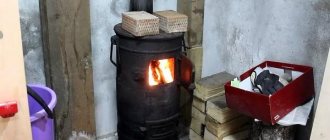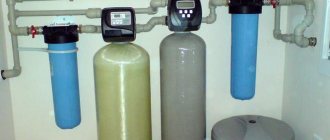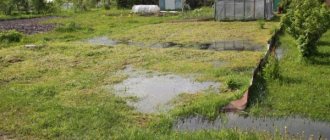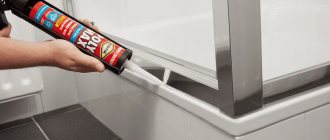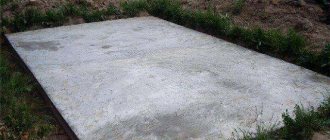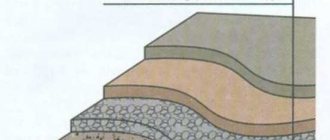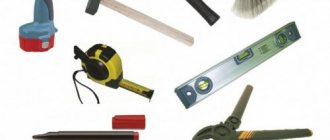Structurally, the tank is a chamber equipped with a siphon partition, a removable basket and an upper protective grille. Some tank models provide additional elements in the form of a reinforcing edging, seals, a lid and an extension to the storm drain element. In addition, the storm water inlet design provides two options for water drainage:
- Removing liquid downwards. Such storm drain elements direct water into the ground, directly into the drainage well.
- Removing drains to the side. Such a tank is connected to pipes into a single structure.
All rainwater inlets differ in size, permissible loads, type of material and shape. Stormwater tanks are marked depending on their purpose:
- D. The marking means “rain inlet”. The element is used in private areas and in pedestrian areas.
- DB1 and DB2. Interpreted as “large rainwater inlet”. Installed in parking lots and along city roadways.
- DM1 and DM2. Main storm water inlet.
- DS1 and DS2. Extra-heavy rainwater inlet. Designed for installation in areas with maximum load.
- DK. The rainwater inlet is round.
Material for manufacturing the element for point collection of rainwater: cast iron, plastic and concrete.
Cast iron storm water inlets
Storm drain elements made of cast iron are the most durable and at the same time the heaviest. SCh20 grade metal can withstand loads of 15 to 25 tons (depending on the dimensions of the tank), is inert to aggressive environments, durable and corrosion-resistant. More often, cast iron storm water inlets are used in the construction of urban sewer lines. The tanks have high throughput and at the same time good environmental friendliness. The metal does not pose a threat to the environment.
Installation of a rainwater inlet in the blind area of a house, provided it has a cast iron structure, must be accompanied by the installation of a special concrete base. Otherwise, the metal will begin to rust. In addition, working with cast iron elements is difficult due to their heavy weight.
Plastic
Polymer tanks are widely used in private and municipal construction. Plastic has the following advantages:
- light weight;
- high resistance to temperature changes;
- inertness to chemical/aggressive environments;
- ease of installation and maintenance;
- wide selection of models in size and shape;
- favorable cost of products.
Caring for polymer rainwater tanks is easy: dirt, silt, and sand can be easily washed off with a stream of water.
All plastic models are marked depending on their rated load:
- A. The load is up to 1,500 kg. This option is good for private construction.
- B. The storm water inlet can handle a load of up to 12.5 tons.
- C. Maximum withstands loads of up to 25 tons.
- D. Load up to 40 t.
- E. Nominally withstands up to 60 tons.
- F. Capable of supporting loads up to 90 tons.
It is better to buy a rain inlet that can withstand a slightly greater load than was obtained in the calculations.
Concrete
This type of rainwater inlet weighs slightly less than a cast iron one. The material is resistant to aggressive drains, durable and has good throughput. But the inner surface of concrete tanks is slightly rough, which causes silt to build up on its walls over time. The accumulated sludge will give off an unpleasant odor as moisture evaporates from the tank. In addition, concrete is a massive material that requires the use of special equipment when laying.
Massive rough concrete can be replaced with lighter and smoother polymer concrete. Polymers added as reinforcing fibers make the final product light, durable, and prone to undergoing high loads.
What it is?
This is a special container into which liquid flows from pipes installed on the facade of the house. This tank must be made of durable material as it faces soil pressure, mechanical loads and water pressure. Storm sewer inlets should not be subject to corrosion.
A rainwater well with a grate can be round, square, oval, or rectangular. This fact does not affect the performance characteristics in any way. The choice of form may be influenced by the design features and style.
What does it consist of?
If you compare storm drains, you will notice that they differ in weight, size and some other features. According to the standard, the depth of the device is 400 mm. As a rule, they are light in weight, except when cast iron is used as the material.
Please note! Reservoirs can be sold as a complete set or individual elements.
- The container itself.
- A basket that is installed inside the water intake.
- Partition or siphon.
- External grille.
In different types, these elements can be made of different materials, which affects the final quality of the product. As for the grille, it is necessary to choose a high-quality and durable one, since it encounters mechanical stress when pedestrians walk and even when hit by a car.
Varieties
Stormwater wells vary in the material used. Devices available for sale include:
To make the right choice about where and which one is best to install, let’s consider their technical characteristics, as well as their pros and cons.
Made of cast iron
An important feature is its heavy weight. At the same time, it is capable of handling loads of up to 90 tons. Thanks to these technical characteristics, cast iron products are used in places where heavy loads are expected:
- Roadway.
- Car gas stations.
- Car parking.
- Highways.
- Pedestrian areas.
They cope well with sudden changes in air temperature and have a large throughput capacity, so there will definitely be no stagnation of water. In their shape, such products are square, round and rectangular. Depending on the shape, the corresponding protective grille is selected.
These designs have been less popular in recent years, as they have been replaced by new technologies that are much easier to install.
Made of plastic
Plastic baskets are the most popular. And this is not strange, because the material is lightweight, which simplifies its transportation, installation and maintenance. Modern modifications make it possible to cope with temperature changes from -40 to +90 degrees Celsius. Mainly used in arranging private houses and cottages. The material is based on polymer concrete, polyethylene and polypropylene.
Cast iron receivers
Most are installed to remove moisture from roads. Cast iron – SCh20 has a lot of advantages. These include wear resistance, durability, and resistance to reagents. Cast iron products differ in shape, weight, and load they are ready to accept.
- DM - rectangular model. Weight 80kg or more. Withstands 12.5 tons.
- Models DM1 and DM2 are used for yard storm sewers and highways.
- DB is also a rectangular model. Weight 115 kg minimum. Can withstand DB2 25 tons. Fits well on a freeway with active traffic.
- DK is a model in the shape of a sphere. Weight up to 100 kg. The DK rainwater inlet is used as a spare while the main one is under repair.
- Load 15 tons.
Installation of storm water inlets DM, DB and DK requires special equipment.
Advantages of cast iron products
- Ready for large volumes of waste water
- Strength
- Long service life
- Cast iron is an environmentally friendly material
- Does not rust
- Loyal price
Disadvantages of cast iron rainwater inlets
- Heavy weight
- Without special coating, susceptible to corrosion
- Installation requires a security system to prevent theft.
In the private sector, the DB1 model is used - a small receiver with a cast iron grille.
By its design, a rainwater inlet is a special container, the purpose of which is to accumulate water flowing down or coming from underground. An important requirement for this sewerage part is the strength of the structure, which must be sufficient to withstand the load, both from flowing water and soil pressure. Another requirement is resistance to corrosion, since the very purpose of the part requires constant contact with water.
In other words, the storm water inlet serves as a container for collecting water. Its use is required not only to drain the site and fertile soil, but also to create reliable protection for the foundation and walls of the house from flooding during heavy rains.
Also, the design of this part of the storm drain is made in such a way as to protect it from the penetration of various debris, for example, leaves. This helps protect your drain pipes from clogging.
Types of storm water inlets
Modern industry offers several types of rainwater inlets based on the materials used to make them. The most common are:
- cast iron models;
- plastic storm water inlets;
- made of reinforced concrete;
- polymer concrete models.
Each type of material must be used in accordance with the destination and installation of the future storm drain in the general storm sewer system.
Since storm drains are most often used in places of high load (these can be highways, places where people often pass by or there is a large amount of incoming water), the most common version of this part is cast iron.
Cast iron rainwater inlets available on the modern market are available in a variety of configurations and sizes. The size of the stormwater inlet will depend on the amount of water expected to be received. It is very important to choose the correct volume of this part to prevent water from overflowing when accumulating. Cast iron rainwater inlets have increased strength, can withstand weight up to 90 tons, and are also able to withstand the negative effects of many aggressive environmental factors.
The main disadvantage of such models is their high price, which is several times higher than the cost of a similar product made of polymer material. Also, in the wake of the growth of hunters for ferrous metals, when installing rainwater inlets made of cast iron, it is necessary to provide safety measures.
Plastic rainwater inlets are mainly used to perform the function of local water collection. The places where they are installed are garden plots, garages, balconies and drainage systems from the roofs of residential buildings.
Such varieties have their undeniable advantages. First of all, it is ease of installation and lightness of design. It is even possible to install plastic storm water inlets on top of each other to obtain the required container volume. The smooth inner surface also makes the device easy to clean. According to statistics, such models are much less likely to clog.
The size of the part is selected depending on the function performed and the volume of incoming water. With an increased catchment area, the chamber dimensions should be increased. The most convenient option are square models, the side size of which is 300 mm.
Another type of plastic storm water inlets is a plastic drain, which is used when introducing a sewer pipe directly into the water collection area.
Division of rainwater inlets by strength class
Storm water inlets are divided not only according to the type of materials they are made of, but also according to their strength class. Knowledge of this classification will allow you to make the right choice when purchasing a specific model and designing a storm drain.
- A 15. The lowest strength class, which is only 15 kN or 1.5 tons. Typically, such models are installed in public gardens, parks, and sidewalks. In places where the load on the device will be minimal;
- B 125. The second most durable storm water inlets, which can withstand loads of up to 125 kN or 12 tons. They are installed in garages where cars are kept;
- C250. The next strength class, the load value of which is already 25 tons. They can be installed on large highways, places with a large number of passing vehicles, regardless of class (cars or trucks);
- D These models can withstand loads of up to 40 tons and can be used in automotive or industrial plants;
- E600. The next class, which is used mainly at sea berths and warehouses where there is increased cargo traffic;
- F The strongest class of rainwater inlets in terms of strength, the scope of which is truly limitless. They can be used at space industry facilities, airports, and military bases.
Advantages and disadvantages
Now in the table we propose to compare all the listed devices made from different materials. For comparison, let's imagine their positive and negative sides:
| Material | Advantages | Flaws |
| Cast iron |
|
|
| Plastic |
|
|
| Polymer concrete |
| Free from noticeable flaws |
How to choose
Regardless of the type of drainage tank, it is necessary to select it correctly. First of all, the following factors should be taken into account:
- Estimated amount of precipitation in your area and its intensity.
- The area of the rainwater collection system.
- Features of the landscape of the local area.
If we are talking about installation near the house, then it is enough to choose a lightweight plastic drain. If there is heavy rainfall in your area, then it is better to give preference to products made of cast iron, as it copes with heavy loads more effectively. It may be worth purchasing a device for several sections or a single section will be enough. Plus, it’s good when the design has a removable basket, a siphon and a primary filter for cleaning.
Locations
If the water intake element is installed incorrectly, this can lead to the accumulation of water in the local area. In this matter, it is necessary to build on the approved provisions of GOST and SNiP. The fundamental norm from which to build is SNiP 2.04.03-85 “Sewerage. External networks and structures." In particular, GOST 26008-83 provides for the mandatory installation of rainwater inlets in the following places:
- On long descents.
- In places where sidewalk paths intersect.
- In low areas along the terrain.
- In all places where there is no natural outflow of water from rain, melted snow, etc.
- Under the drainpipe.
- Along the edges of highways.
- Before entering the building.
Why is it necessary to place rainwater inlets for storm drainage?
A modern, efficient storm drainage system contains several components that must cope with the drainage of rain and melt water. These include:
- Linear external water collectors, which are installed at a slope along the blind area and paths;
- Point storm inlets that collect water coming from downspouts, linear catch basins, and low-lying areas in the landscape where a lot of water quickly accumulates.
Usually, without installing an entire system of storm water inlets, it is impossible to effectively organize the collection and drainage of rain and melt water from a site, especially in areas with complex landscapes, where it is simply impossible to solve the problem with the help of linear gutters due to the lack of a natural slope of the area towards the boundaries of the site from its center.
Features of installation and installation with your own hands
The installation of the highway begins with earthworks. However, before this it is recommended to prepare a project and make a drawing. Thanks to this, you can determine what kind of installation scheme will be: point or linear. Moreover, before starting work, you should determine the dimensions of the blind area. The process looks like this:
- A pit is dug according to the depth of the purchased receiver. It is necessary to add 400 mm to this depth. As for the width, at the edges it should be 30 mm wider on all sides. This will allow you to install a well water receiver and fix it with concrete.
- Next, the base is prepared. A cushion of sand and crushed stone is made at the bottom. To compact it well, first water it with water.
- Pre-install it in the pit and connect it to the sewer and drain pipes. Make sure that the drainage level is completely maintained. The settling receiver must be level, and at the same time the pipes from it must diverge with a slope.
- After checking everything, pour a small amount of concrete onto the bottom.
- Next, press the rainwater inlet tightly, but so that the nozzles coincide with the pipes.
- It is also necessary to immediately fill the areas around it with concrete.
- Finally, all that remains is to complete the assembly by installing the basket, siphon, grill, etc.
Required materials and tools
When installing storm drains, the following materials are used:
- point storm water inlets, pipes, drainage trays, roof gutters, gratings and sand traps;
- sand and crushed stone;
- concrete or plastic rings for the manhole;
- sealant;
- brackets;
- cement;
- pipe corner elements.
The main materials for the manufacture of storm drains consist of cast iron, plastic, aluminum, and steel. In addition, you need to prepare the following tools to get started:
- Shovel. Used when digging trenches;
- Hacksaw for metal. Cuts pipes to the required size;
- Wrenches, screwdriver, screwdriver, file, screw cutting boards.
Maintenance, operation and care
In order for the water drainage system, drainage and similar communications to work properly, it is necessary to take seriously the rules for operating the rainwater inlet. The whole point of care comes down to emptying the trash bin in a timely manner. 2-3 times a month is enough. If there was little rain during this period, then cleaning is not necessary.
Important! If there is heavy precipitation in your area, then care must be taken to clean not only the receiver itself, but also the pipes leading from it.
Video description
Storm sewer installation.
How to care
Water inlets are the most maintenance-demanding element of a storm drain. The water entering the structure is cleared of coarse debris while still on the surface. If you don’t have time to clean frequently, then professionals recommend installing models with fine mesh. The sand catcher parts are emptied of contents as they are filled (once every 3 months).
The storm water inlet, trays and basket are washed in water. Mold and algae are removed with a scraper or spatula. If you do not deal with plaque, the tank will become a source of stench. The surface is treated with a solution for water pipes, then scraped off using a tool.
How to clean a water inlet Source makler.ua
Installation of rainwater inlets in surface drainage systems.
Summer 2021
Hurry up to buy artificial stone facing tiles with rocky texture (artificial rock stone) at a discounted price!
An excellent material for finishing facades and plinths - maximum wear resistance, excellent appearance.
The price is reduced by 15% during the promotion! We invite you to our showroom, where we have a wide collection of all models and colors of White Hills artificial stone.
Storm water inlet, as well as drainage tray
, absorbs all possible hydraulic loads and loads associated with soil dynamics. Therefore, for long-term and problem-free operation of the surface drainage system, proper placement of the rainwater inlet in the ground is required. It is necessary to understand that in many cases drainage trays are adjacent to the storm inlet, and if the integrity is damaged, the entire system will suffer.
Storm water inlets for storm drainage
- Storm drain task
- Types of storm water inlets for storm drainage Concrete storm water inlets
- Storm water inlets made of cast iron
- Rainwater inlets made of plastic
Storm drain task
Rainwater in summer and melt water in spring accumulates in the ground and over time erodes the foundation of the building. The result: the building will begin to sag. The purpose of storm drainage is to remove all water from the surface. The drainage system will help protect buildings; puddles will not stagnate on the site, so pedestrian paths and sidewalks will last longer. The water intake well consists of a simple design: water flows into the storm water inlet from a flat surface, then passes through the drains into the sewer system.

